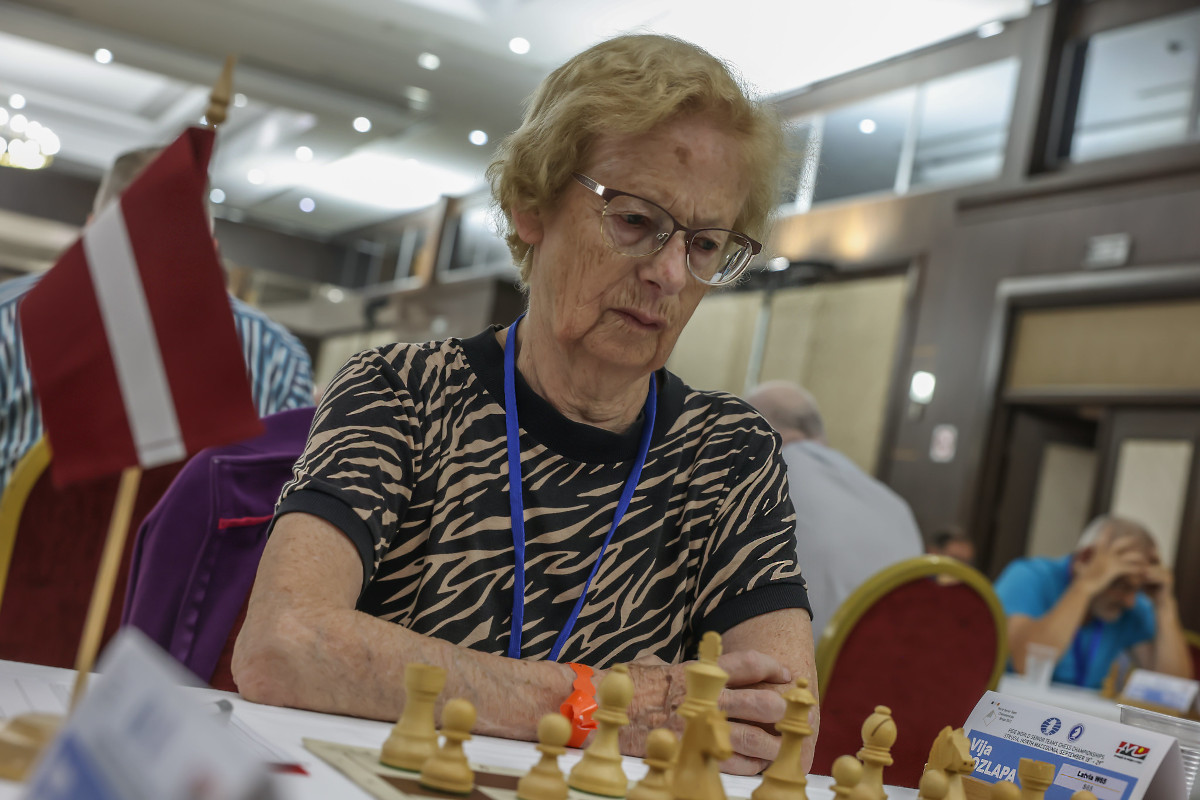


The first round of the FIDE World Senior Team Championship saw the favourites play weaker teams, as it is usually the case in Swiss events. However, this didn’t mean there weren’t certain surprises on several boards.
In the S50 section, the number one seed team, the United States, won 3½-½ against Canada, but they were on the verge of defeat on board one. Victor Plotkin (2193) was winning in the endgame against Alexander Shabalov (2465), but did not manage to convert the Fischer-esque endgame of rook and bishop vs. rook and knight.

The playing hall | Photo: Mark Livshitz
On the other boards, Kaidanov (2549), Ehlvest (2530) and Novikov (2513) didn’t have problems overcoming Barron (2108), Findlay (2123) and Dougherty (2062), respectively.
In the game Findlay vs Ehlvest Black played a pretty two-move combination.
Black started with 23…Bb4, freeing the eighth rank, and 24.Qc1 Nxg3! led to immediate resignation in view of …Rg8 next, when mate on the g-file would follow shortly. 0-1
In the duel between the English teams (England 1 and England 3) the higher-rated team prevailed. Yet even on board one, Michael Adams (2662) couldn’t overcome Granat (2171) with the white pieces.
It was a tough fight on boards two and three, where Emms (2448) won a long rook endgame against Crocker (2161) with Black and Arkell weaved his magic in his favourite Carlsbad structure to suffocate Frostick (2112).
Only on board four, Davies (2354) won easily against Hewson (2023), partly because of a successful opening surprise. Playing the Benoni with Black, he obtained an advantageous position early in the game, which he converted in a convincing fashion.
Italy beat England W50 4-0, and in this match, we saw a spectacular game between Ortega (2410) and Jackson (2034).
White (Ortega) reached a winning position, and here 27.e5! (freeing the e4-square for the knight) would have been decisive. Instead, after Ortega’s 27.b3? Ne5 Black was suddenly not worse at all!
Several moves later, with both sides trading imprecisions, White was winning again.
Here 33.Qf5 was decisive, as the king can hide on f4 in case of checks. Instead, Ortega went for the overambitious queen sacrifice 33.Qxg4? Rg1 34.Kxf3 Rxg4 35.Kxg4 Bxc3, which landed him in a lost position!
With only a rook for a queen, White perhaps was counting on 36.Rxb7, with the idea of Rb8, creating threats against the black king and also planning b7. In order to prevent Rb8, Black now should have played 36…Qe8!, but instead he erred with 36…Qb5? after which 37.Kf5 was the best continuation.
However, following his plan, White played 37.Rb8? and now after 37…Qe2 Black was winning again!
Ortega went boldly ahead with 38.Kg5, but 38…Bd2 would have led to a forced mate. 38...Bf6, as played by Black, was also sufficient to win the game. White sent his king all the way to h7, creating a mating threat of Rf8, and Jackson correctly sacrificed the bishop with Bg7.
However, instead of winning with 41…Qxc2 or 41…Qe1, Black made a fatal mistake by grabbing the f2-pawn. Suddenly after 41…Qxf2?? 42.Nf5 White was winning!
White hides from the checks with Nh6, and the b-pawn will promote. 1-0
An incredible game!
The host team of North Macedonia Alkaloid whitewashed USA 5 Brothers, and in many other matches, the favourites were also rather ruthless.

Vlatko Bogdanovski (North Macedonia Alkaloid) | Photo: Mark Livshitz
In the S65 section, the resistance of the underdogs was tougher. The top three favourites all won 3-1, allowing two draws in their matches.
In the match on board one between Switzerland and Germany Lasker Schachstiftung GK, the German Grandmaster Kalintschew (2377) won a high-tempo game against Kradolfer (1912). The final position deserves a diagram.
White resigned as 26.Bg1 Re1! leads to mate. 0-1
The English team led by John Nunn (2569) won by the same score, making draws on board one, where Nunn played the currently out-of-fashion Velimirovic attack. True to his style, John obtained a nice attacking position, but then, instead of continuing in the same vein, he switched to a positional route.
Here, a typical Velimirovic sacrifice 15.Nf5! was very strong, but Nunn chose the second-best 15.b4, which gave him an extra pawn after mutual imprecisions, but in an endgame with rooks and opposite-coloured bishops, he couldn’t convert his advantage.
The Slovak number one, Lubomir Ftacnik (2452), had a similar fate, as he could only achieve a draw from an inferior position against Burchardt (2153) from the Germany W65 team.
The close matches at the start of the S65 section indicate that this will be a very closely fought event.
A good example of underdogs’ resilience is the victory by the host team of North Macedonia over Italy (2⅔-1⅔), with a draw on board one between Ilic (2044) and Garcia Palermo (2410), wins for Kralevski (2054) and Stosevski (1968) against Messa (2289) and Cocozza (2226), and a loss for Hadzi-Manev (1865) against Trabattoni (2232).

Vija Rozlapa (Latvia W65) | Photo: Mark Livshitz
| Advertising |